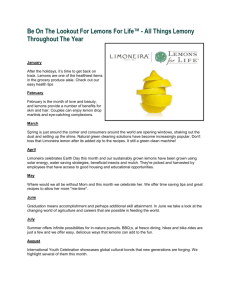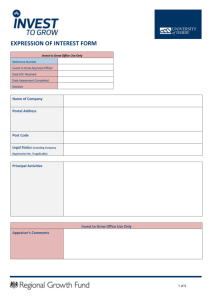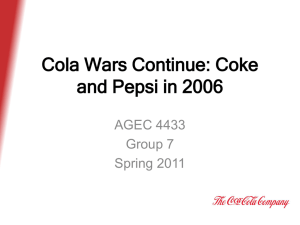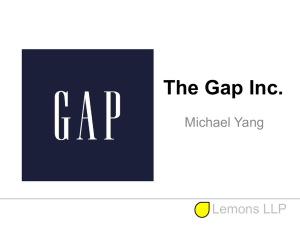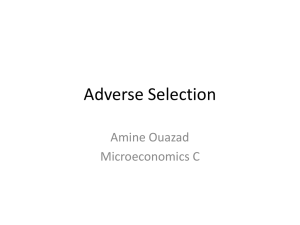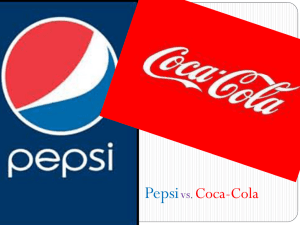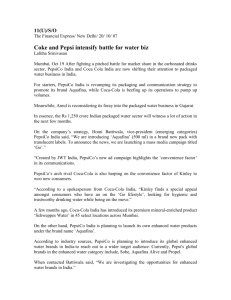CMP Final Review with Solutions
advertisement
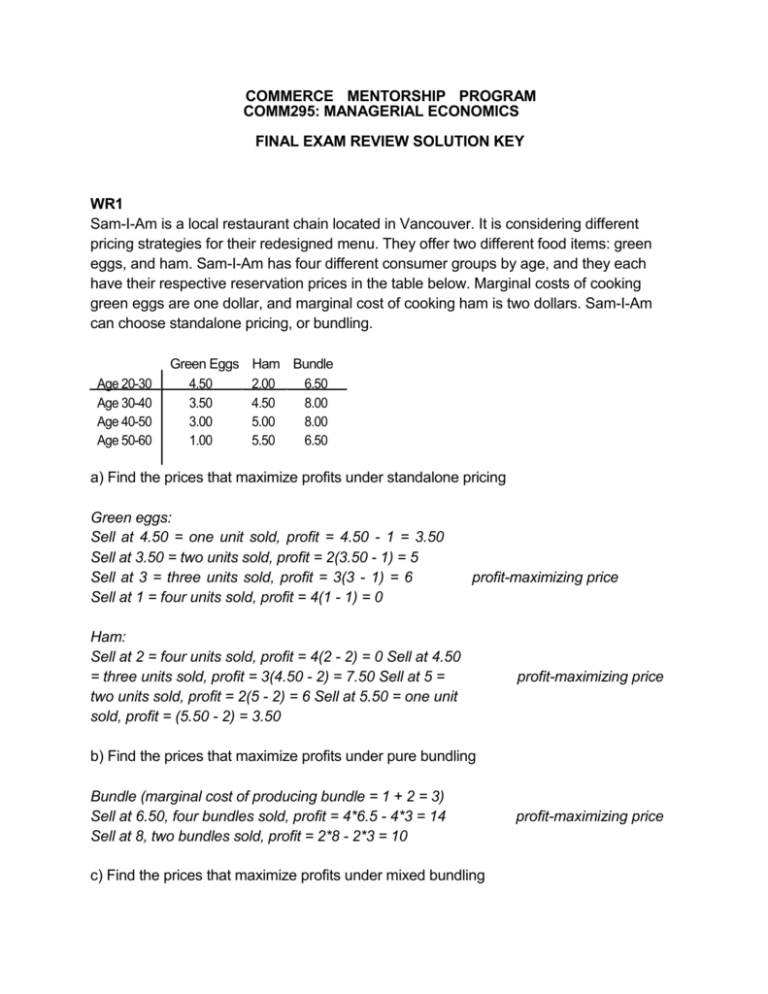
COMMERCE MENTORSHIP PROGRAM COMM295: MANAGERIAL ECONOMICS FINAL EXAM REVIEW SOLUTION KEY WR1 Sam-I-Am is a local restaurant chain located in Vancouver. It is considering different pricing strategies for their redesigned menu. They offer two different food items: green eggs, and ham. Sam-I-Am has four different consumer groups by age, and they each have their respective reservation prices in the table below. Marginal costs of cooking green eggs are one dollar, and marginal cost of cooking ham is two dollars. Sam-I-Am can choose standalone pricing, or bundling. Age 20-30 Age 30-40 Age 40-50 Age 50-60 Green Eggs 4.50 3.50 3.00 1.00 Ham Bundle 2.00 6.50 4.50 8.00 5.00 8.00 5.50 6.50 a) Find the prices that maximize profits under standalone pricing Green eggs: Sell at 4.50 = one unit sold, profit = 4.50 - 1 = 3.50 Sell at 3.50 = two units sold, profit = 2(3.50 - 1) = 5 Sell at 3 = three units sold, profit = 3(3 - 1) = 6 Sell at 1 = four units sold, profit = 4(1 - 1) = 0 profit-maximizing price Ham: Sell at 2 = four units sold, profit = 4(2 - 2) = 0 Sell at 4.50 = three units sold, profit = 3(4.50 - 2) = 7.50 Sell at 5 = two units sold, profit = 2(5 - 2) = 6 Sell at 5.50 = one unit sold, profit = (5.50 - 2) = 3.50 profit-maximizing price b) Find the prices that maximize profits under pure bundling Bundle (marginal cost of producing bundle = 1 + 2 = 3) Sell at 6.50, four bundles sold, profit = 4*6.5 - 4*3 = 14 Sell at 8, two bundles sold, profit = 2*8 - 2*3 = 10 c) Find the prices that maximize profits under mixed bundling profit-maximizing price Can sell bundle for highest possible price (8), while offering standalone prices that maximize profit. Sell bundle for 8 = two bundles sold, profit = 2*8 - 2*3 = 10 Sell green eggs for 4.50, one unit sold, profit = 4.5 - 1 = 3.5 Sell ham for 5.50, one unit sold, profit = 5.5 - 2 = 3.5 d) What strategy yields the highest profit, and what is the profit? Mixed bundling offers the highest profit, with a total profit of 17. WR2 Sourface, a beverage company, is ordering a shipment of lemons. Suppliers gather boxes of lemons from California and from Florida. A recent wildfire has burned the lemons from California, and although it cannot be seen from the outside, those lemons have no value. Sourface values California lemons at $15/box and Florida lemons at $45/box. Supplier reservation prices are $10/box for California lemons and $30/box of Florida lemons. a) If Sourface can see which lemons are from where, what price would they pay for a box of lemons from Florida? If Sourface can see which lemons are from where, there is full information, and no asymmetry. They will be able to differentiate between lemons from each area, and would be willing to pay full value for good lemons. They would pay a price of $45 a box. b) What proportion of lemons in the market need to be from California for there to be adverse selection? For adverse selection to occur, the offer price must be lower than the Florida lemons reservation price, as that is the condition needed for sellers to refuse to sell the good lemons. The offer price is a weighted average of prices dependent of the proportion of good to bad lemons in the market. Let p = proportion of Florida lemons in the market, and 1 - p = proportion of California lemons in the market. Offer price < Florida reservation price 45p + 15(1 - p) < 30 45p + 15 - 15p < 30 30p < 15 p < 15 / 30 or p<½ or (1 - p) > ½ For there to be adverse selection, more than half of the lemons in the market would have to be from California. c) If 80% of lemons are from California, will supplier sell Florida lemons? What if 25% of lemons are from California? If 80% of lemons are from California, that satisfies the condition derived from b), there will be adverse selection Offer price = 45(0.2) + 15(0.8) = 9 + 12 = 21 < reservation price, suppliers won’t sell If 25% of lemons are from California, that does not satisfy the condition Offer price = 45(0.75) + 15(0.25) = 37.5 > reservation price, suppliers will sell WR3 Mowtivation is a lawn-care company. Their employees are mostly self-monitored, and they can choose to work when they want. The company’s revenues are dependent on two variables: how long employees work and the state of the economy, and shown in the table below. Skip Work Good Effort Overtime 40% Boom 12 18 25 60% Bust 6 10 13 Cost of Effort -3 5 10 Management can offer three compensation packages: a fixed wage of 10, a 70% share of revenue, or a performance bonus where employees only get paid if the company gets 15 in revenues. In that case, they will receive all revenues in excess of 15. a) What will the employees choose under each compensation structure? Under fixed wage = 10 Skip work: 10 - (-3) = 13 Good effort: 10 - 5 = 5 Overtime: 10 - 10 = 0 Employees will choose to skip work Under 70% share of revenue Skip work: 0.7(12*0.4 + 6*0.6) - (-3) = 8.88 Good effort: 0.7(18*0.4 + 10*0.6) - 5 = 4.24 Overtime: 0.7(25*0.4 + 13*0.6) - 10 = 2.46 Employees will choose to skip work Under bonus excess of 15 Skip work: no chance of getting bonus = 0 - (-3) = 3 Good effort: 0.4*(18 - 15) - 5 = -3.8 Overtime: 0.4*(25 - 15) - 10 = =6 Employees will choose to skip work b) If shareholders can choose the pay structure, what structure will they select? Shareholders will want to maximize the profit of the firm Fixed wage: 12*0.4 - 6*0.6 - 10 = -1.6 Revenue share: (12*0.4 - 6*0.6) - 0.7(12*0.4 - 6*0.6) = 2.52 Bonus: 12*0.4 - 6*0.6 - 0 = 8.4 Shareholders would choose the bonus because that would maximize profits c) If the employee’s direct manager can choose, what structure will they select? Managers may want to maximize revenues instead of profits for the firm. Assuming this is the case, since under each pay structure, the employees will choose to skip work, the expected revenue would be the same in every case. Direct managers will be indifferent between compensation options. WR4 The market for bottled water can be considered competitive. The market demand for bottled water can be expressed in the form of P = 300 - 2Q. Marginal cost of producing a bottle of water is constant at 4. a) List several properties of a competitive market. Competitive markets have many sellers, selling identical or similar goods, without any market power to set the price (price takers) b) What is the equilibrium price and quantity? Competitive markets will produce where MR = P = MC, so P = 300 - 2Q = 4 2Q = 296 Q = 148 P = MC = 4 c) What is the consumer and producer surplus? Is there dead-weight loss? Draw a graph of the market, area of triangle = surplus. In a competitive market, all surplus goes to the consumer and there is no dead-weight loss, CS = 148*(300 - 4)/2 = 21904. Now suppose that Aquafina has market power, and decides to undergo first-degree price discrimination. d) What is the equilibrium price and quantity? The price will simply be how much the consumer is willing to pay. If they are willing to pay 200, they will pay 200. If they are willing to pay 30, they pay 30. However, firms will not sell to them if they are not willing to pay a price above or equal to 4. Any price below 4 results in a loss. The quantity produced is where P = MC = 4 e) What is the consumer and producer surplus? Draw a graph of the market, area of the triangle = surplus. In a first-degree price discriminatory market, all surplus goes to the producer, PS = 21904 Now suppose that Aquafina, Evian, and Dasani acquire every other firm in the market, so now only these three firms exist. f) If the three firms decide to form a cartel, what is the quantity that each firm produces, and what is the price that water is sold at? To find cartel output, first find monopoly output, because that maximizes profits for the firm. MR = 300 - 4Q = MC = 4 4Q = 296 Q = 74 This quantity is evenly split among the three firms. Each firm would produce 24.67 units Total quantity is plugged into the demand function to find price, P = 300 - 2(74) = 152 Evian and Dasani decide to consolidate into a single company, Dasanevian. This firm and Aquafina are the only two firms in the market. Marginal costs of producing a bottle of water is still 4 for Aquafina, but decreased to 2 for Dasanevian because of scale. g) What is the Cournot equilibrium? Express the equilibrium in a graph. P = 300 - 2Q Q = QD + QA P = 300 - 2QD - 2QA MRD = 300 - 4QD - 2QA = MCD = 2 4QD = 298 - 2QA QD = 74.5 - QA/2 Dasanevian’s BRF MRA = 300 - 2QD - 4QA 4QA = 296 - 2QD = MCA = 4 QA = 74 - QD/2 Aquafina’s BRF Plug one equation into the other, doesn’t matter which one, because the game is simultaneous QD = 74.5 - QA/2 QD = 74.5 - 37 + QD/4 3QD/4 = 37.5 QD = 74.5 - (74 - QD/2)/2 QD = 50 Plug QD into Aquafina’s BRF Q = 50 + 49 = 99 QA = 74 - 50/2 P = 300 - 2(99) = 102 = 49 h) What is the Bertrand equilibrium? We can consider water as an identical good. When firms are producing identical goods, firms will produce at a price equal to the marginal cost (similar as in perfect competition). However, in this case, Dasanevian’s consolidation resulted in lower marginal costs as a result of scaling. This lower marginal cost means that they can undercut further, and take all the market, and Aquafina cannot continue undercutting, because they would make a loss. The market equilibrium price is marginally below Aquafina’s marginal cost of 4, so at 3.99. Dasanevian would produce at 3.99 = P = 300 - 2Q, so Q = 148 WR5 Over the course of a year, Bob earns $40,000, of which $2,000 he allocates towards “recreational activities”. His two main activities consist of buying video games, where he gets to shoot arrows into people’s knees, or going to the shooting range, where he gets to shoot bullets into people’s heads. A video game costs $50, and trips to the shooting range cost $80 each trip. His utility function is expressed by U(V,S) = 2VS2, where V = number of video games and S = number of trips to the shooting range. a) What is his budget line? Graph this budget line with video games on the x-axis. Sketch at least three indifference curves on the graph as well. His budget line is aV = bS = C, where a and b are prices, and C is the budget. Therefore, it would be equal to 50V + 80S = 2000 b) What is Bob’s marginal utility of each activity? MUV = dU/dV = 2S2 MUS = dU/dS = 4VS c) What is the marginal rate of substitution? MRS is equal to the slope of the indifference curves Slope of indifference curves = -MRV / MRS = -2S2 / 4VS = S/2V d) How should Bob spend his money to maximize his utility? Maximize utility by having MUV/PV = MUS/PS or when the MRS = MRT 2S2 / 50 = 4VS / 80 S / 25 = V / 20 V = 20S / 25 = 4S / 5 Plus ratio into budget line: 50V + 80S = 2000 50(4S/5) + 80S = 2000 40S + 80S = 2000 S = 16.67 V = 13.33 He should make 16.67 trips to the shooting range and buy 13 video games WR6 Demand for Jagermeister is expressed by QD = 122 - P - 4PR while supply is expressed by QS = 20 + 0.5P. PR is the price of Red Bull. Assume PR = 2 where necessary. a) What is the equilibrium quantity and price? Demand: Q = 122 - P - 4*2 = 114 - P Supply: Q = 20 + 0.5P 114 - Q = 2Q - 40 3Q = 154 P = 114 - Q P = 2Q - 40 Q = 51.33 P = 2*51.33 - 40 = 62.67 b) What is the arc price elasticity when the price drops from 100 to 80? QD(P = 100) = 114 - 100 = 14 QD(P = 80) = 114 - 80 = 34 Arc price elasticity of demand = (averageP*∆ Q)/(averageQ*∆ P) = (90*20)/(24*-20) = -3.75 c) What is the cross-price elasticity of demand? Is Red Bull a complement or a substitute? Cross price elasticity = dQ/dPR * P/Q = -4*(62.67/51.33) = -4.88 Complement d) For simplicity’s sake, now assume that QD = 122 - P. If the government imposes a tax of $10 on Jagermeister, how much of the tax is borne on consumers, and how much is borne on producers? With demand QD = 122 - P, Q = 54 and P = 68 Think of the tax as a price-increase, and look at the contributions from both consumers and producers We want to find the values of a and b, where a - b = tax = 10 Demand - Supply = 10 Q = 50.67 a = 122 - 50.67 = 71.33 b = 2(50.67) - 40 = 61.33 122 - Q - (2Q - 40) = 10 162 - 3Q = 10 a - b = 10 From this we can see that the consumer pays 3.33 of the tax by paying 71.33 , while the producer pays 6.67 of the tax by receiving only 61.33 WR7 Hooligan Incorporated is a firm specializing in producing grenades. The production function for grenades is expressed by the function Q(L,K) = 9L3K, where L is units of labour and K is units of capital. a) What are the marginal products of labour and capital? MPL = dQ/dL = 27L2K MPK = dQ/dK = 9L3 b) What is the average product of capital if L = K = 4? APK = Q/K = 9L3K/K = 9L3 APK (4,4) = 9*(43) = 576 c) If wages cost $3 and rentals cost $5, what is the ratio of labour to capital that minimizes cost? Minimize cost at MPL / PL = MPK / PK (27L2K / 3) = (9L3 / 5) 9K = 9L/5 L = 5K Labour to capital ratio should be 1/5 or 0.2 WR8 Coca-Cola and Pepsi are competing simultaneously and each one is trying to beat the other in developing a secret chemical that makes their drink taste better. The company that produces the chemical first will see their revenue double. If both firms choose to invest in research, then they’ll find the chemical at the same time and experience no benefits. Research costs are $200,000, and currently firms have revenues of $500,000. a) Fill in the payoff matrix. Are there any dominant strategies? What is the outcome of this game? Pepsi Don't Invest Invest Coca Cola Don't Invest 500000,500000 800000,500000 Invest 500000,800000 300000,300000 Neither firm has a dominant strategy, so the Nash equilibrium will come from players playing their best strategy in response to the other player’s strategy. There will be two Nash Equilibrium: Pepsi invests and Coca-Cola doesn’t invest Pepsi doesn’t invest and Coca-Cola invests b) Suppose the game is sequential, with Pepsi being the first mover. Draw the game in extensive form and solve for the subgame perfect Nash Equilibrium. Invest Invest 300000,300000 Don't Invest 800000,500000 Invest 500000,800000 Don't Invest 500000,500000 Coca-Cola Pepsi Don't Invest Coca-Cola Subgame perfect Nash Equilibrium: Pepsi invests If Pepsi invests, then Coca-Cola will not invest If Pepsi doesn’t invest, then Coca-Cola invests Suppose the payoffs for each firm change, and are now described in the tree: Invest Invest 400000 , 300000 Don't Invest 450000 , 500000 Invest 500000 , 600000 Don't Invest 800000 , 400000 Coca-Cola Pepsi Don't Invest Coca-Cola Pepsi is considering making a direct payment to Coca-Cola to ensure that Coca-Cola will not invest in research. c) What is the maximum that Pepsi will be willing to pay? Pepsi would be willing to give a maximum of 800,000 - 500,000 = 300,000, because that is the difference in payoffs between if Coca-Cola invests and if they don’t invest. If Pepsi has to pay any amount larger than 300,000, then they would just rather let CocaCola invest because then their payoffs would be higher if Pepsi doesn’t invest and Coca-Cola invests. d) What is the minimum that Coca-Cola will be willing to receive? Coca-Cola would accept a minimum of 200,000, because that is the difference in payoffs between if Coca-Cola invests or not. Any amount less than 200,000, and they will still choose to invest because their payoffs are greater. WR9 A derivatives trader is looking at four different funds to invest in. Each fund has a payoff schedule according to what the price level the SPDR (a fund tracking the S&P500) is at a year from now. 20% Fund A Fund B Fund C Fund D < 100 20 10 -50 25 50% 30% If price of SPDR is 100 - 150 > 150 10 -15 7 2 40 40 15 20 a) Calculate the expected value and variance of each fund. E(A) = 0.2*20 + 0.5*10 + 0.3*-15 E(B) = E(C) = E(D) = = 4.5 = 6.1 = 22 = 18.5 Var(A) = 0.2*(20-4.5)2 + 0.5(10-4.5)2 + 0.3(-15-4.5)2 Var(B) = Var(C) = Var(D) = = 73.9 = 4.1 = 1088.6 = 9.8 b) Which fund would risk-seeking and risk-neutral investors select? A risk seeking investor, wanting to maximize expected value and variance, would select Fund C. A risk neutral investor, wanting to maximize expected value, would select Fund C. c) What can you say for certain about risk-averse investors? Without a utility function, we cannot say for sure what a risk averse investor will choose. But we can say for certain that Fund A will not be chosen, because it has a lower expected value than Fund B while having more variance. Fund A is a dominated strategy. You are playing a dice game with a friend. If the eight-sided die lands on a number divisible by 4, you get a payoff of 80. Otherwise you get a payoff of 20. d) What is your expected payoff? Expected payoff = 0.25(80) + 0.75(20) = 35 e) You have a utility function of U(X) = 3X2. Graph this function, with the two potential outcomes, the expected utility, and the expected value. Expected utility = 0.25(3*802) + 0.75(3*202) = 5700 f) What is your risk premium? The risk premium = payoffs from playing the game - riskless payoff that would give you the same amount of utility. Utility from playing = 5700 Expected payoff from playing = 35 Riskless payoff that would give you same utility = (5700/3)0.5 = 43.59 Risk premium = 35 - 43.59 = -8.59 WR10 Draw the demand and relevant cost curves for each type of market, and describe how you would find the equilibrium price and quantity. a) competitive markets (MC can also be upward sloping) Short run: price and quantity at the intersection of Demand and MC P may be greater than AC, so firms can profit Long run: find quantity at the intersection of AC and MC, plug into demand to find price b) monopolistic markets Find quantity at MR = MC, plug into demand to find P c) monopolistically competitive markets Find quantity at MR = MC, find P = AC d) markets with peak and off-peak periods For each period, find quantity at the intersection of MC and MR, plug into demand to find price.


